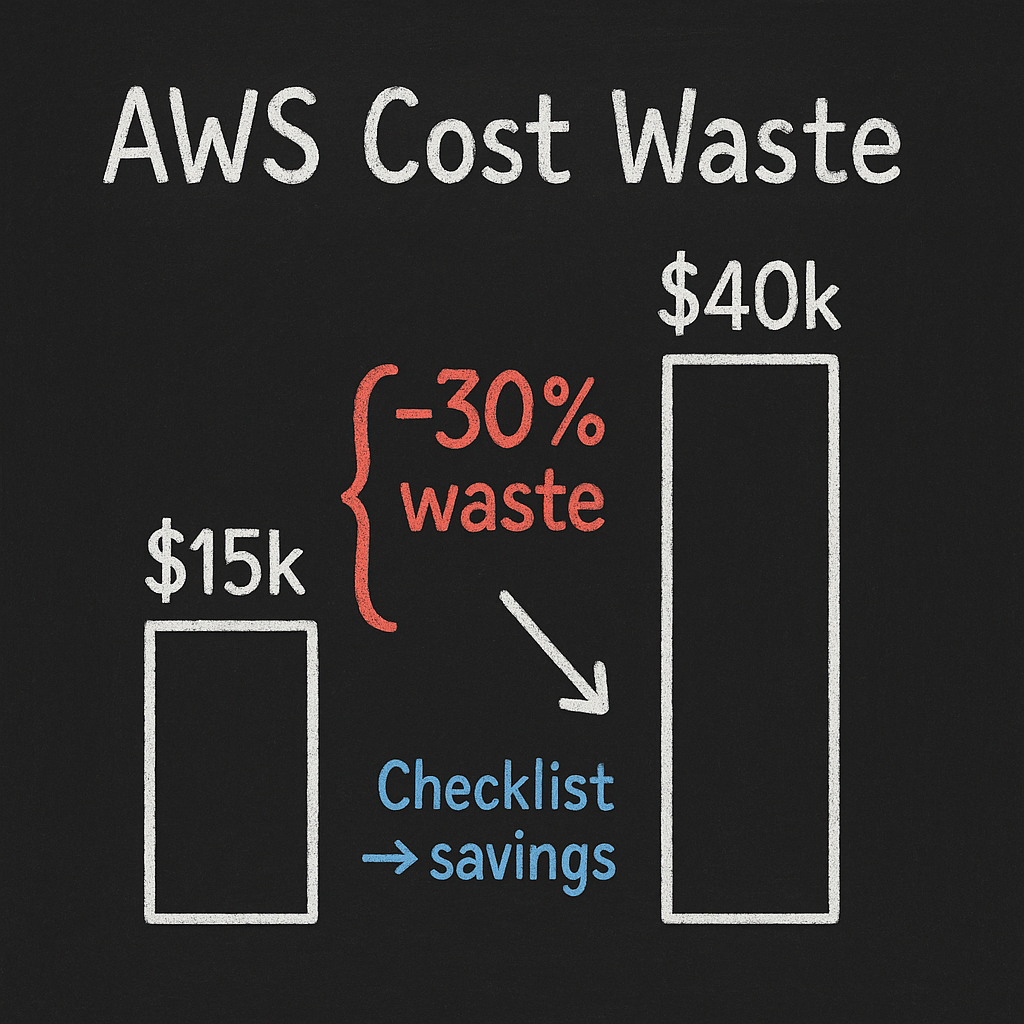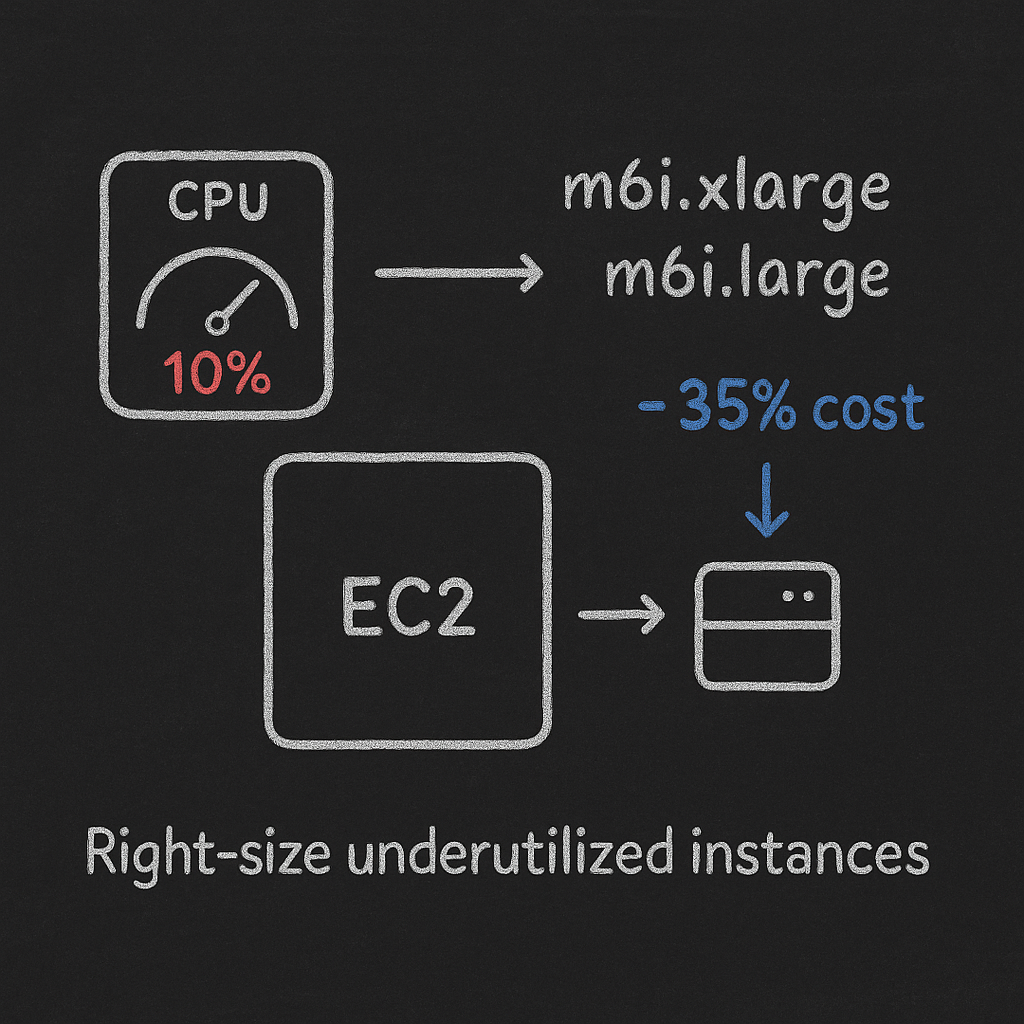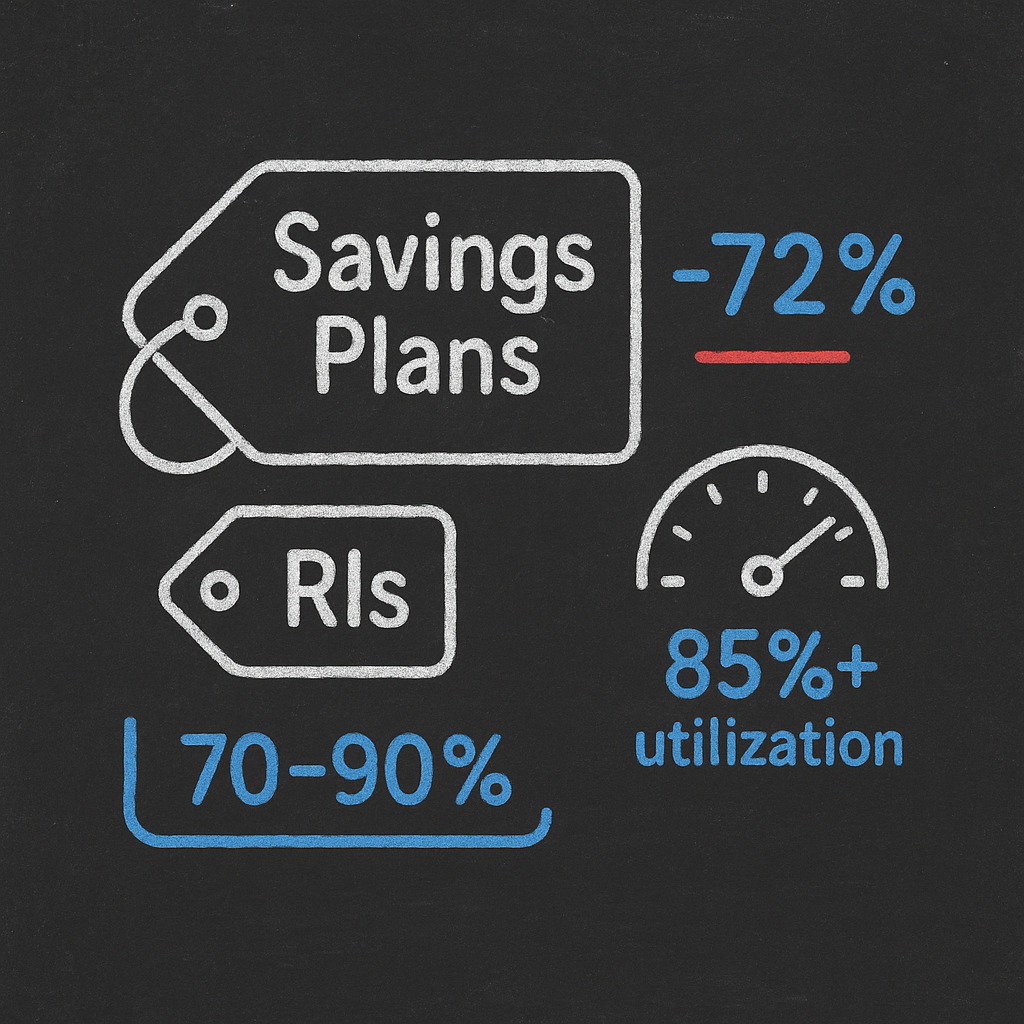AWS cost optimization checklist for startups and scale-ups
You already know AWS bills can spiral fast. One month you’re at $15,000, the next you’re pushing $40,000—and nobody on your team can point to where the extra spend went. Studies show that 30% of total cloud spend represents addressable waste across organizations, yet most engineering teams lack a structured way to hunt it down.

This checklist gives you a practical, step-by-step framework to audit your AWS environment, identify the biggest cost leaks, and implement quick wins without sacrificing performance. We’ll walk through rightsizing, shutting down idle resources, leveraging Savings Plans and Reserved Instances, optimizing storage tiers, and tailoring your approach based on whether you’re a three-person startup or a scale-up with distributed teams.
Why you need a structured cost optimization process
AWS pricing is notoriously granular—EC2, Lambda, and Fargate alone represent 53% of total AWS spend after discounts. That leaves dozens of other services (S3, RDS, EBS, data transfer) each with their own pricing models, usage patterns, and optimization levers. Without a checklist, it’s easy to focus on one area (say, rightsizing EC2) while missing an idle RDS instance draining $800 per month or EBS volumes provisioned at 3,000 IOPS when workloads only use 100.
A structured checklist ensures you systematically cover the highest-impact opportunities. Research shows that quick-wins optimization delivers 6–14% reduction in addressable waste, while tackling priority efforts can yield 8–20% reduction and long-tail work another 3–6%. For a startup spending $50,000 per month, even a conservative 10% reduction puts $5,000 back into your runway every month—or $60,000 annually.
Before you start: Gather your baseline data
Pull 90 days of usage from AWS Cost Explorer and download your Cost and Usage Report (CUR). You need monthly spend by service (EC2, EBS, S3, RDS, Lambda, data transfer), tagged versus untagged resources (many startups have 40–50% untagged instances), instance types and utilization metrics (CPU, memory, network), storage volumes and IOPS utilization, and Reserved Instance and Savings Plans coverage.
Set up AWS Budgets with alerts at 80%, 100%, and 120% of your expected monthly spend. This baseline gives you a clear before-and-after comparison as you work through the checklist. For detailed guidance on forecasting future costs, consult our AWS Pricing Calculator guide.
Step 1: Right-size compute resources (EC2, ECS, Fargate)
Identify underutilized instances
Start with AWS Compute Optimizer or Trusted Advisor to surface instances running below 10% average CPU. According to internal audits, 40% of EC2 instances sit below 10% CPU at peak, and rightsizing typically cuts EC2 costs by approximately 35% with no performance degradation.

Flag instances with CPU utilization consistently under 20% for 30+ days. Check if memory or network are the actual bottlenecks—CloudWatch agent is required for memory metrics. Downsize one instance type smaller (for example, m6i.xlarge to m6i.large) and monitor for 48 hours. Use AWS EC2 auto scaling best practices to dynamically adjust capacity based on load.
For ECS workloads, confirm task definitions aren’t over-requesting CPU and memory. A common issue: tasks requesting 2 vCPU but only using 0.5 vCPU means Fargate charges you for the full 2.
If you’re pre-product-market fit with variable traffic, resist the temptation to provision for theoretical peak load. Start small and scale up when metrics prove it’s necessary. At scale, even small rightsizing wins compound—one percentage point improvement across 500 instances can recover thousands monthly.
Consider Graviton instances
AWS Graviton (ARM-based) instances like m7g or t4g deliver approximately 15% per-instance savings compared to x86 equivalents with comparable or better performance for many workloads. Test Graviton for stateless services, batch jobs, or containerized applications. Most Docker images support multi-arch builds, making the switch straightforward.
Step 2: Shut down idle and forgotten resources
Terminate orphaned instances and load balancers
Look for EC2 instances with zero network traffic for 14+ days, load balancers with zero active connections, Elastic IPs not attached to any instance (charged roughly $3.60 per month per IP), and NAT Gateways serving VPCs with minimal egress. AWS Trusted Advisor cost optimization flags these automatically. One e-commerce client cut development environment costs by 40% simply by downsizing dev instances from m5.xlarge to t3.medium and scheduling them to run only during business hours.
Set up a monthly “resource audit day” to review and terminate unused assets. Tag resources with an expiration date or owner email for accountability. Use AWS Instance Scheduler to automatically stop non-production instances outside working hours—dev and test workloads can save up to 70% this way.
Clean up storage waste
Storage leaks are silent killers. Unattached EBS volumes, obsolete snapshots, and S3 buckets without lifecycle policies all accumulate costs month after month. Delete EBS volumes that have been unattached for 30+ days. Identify snapshots older than 90 days and remove those no longer needed for compliance or disaster recovery. Implement S3 lifecycle policies to transition infrequently accessed objects to Standard-IA after 30 days and Glacier after 90 days.
Review EBS volumes with provisioned IOPS—if you’re seeing only 100 IOPS in CloudWatch but paying for 3,000, optimize your EBS performance settings. For more on storage optimization, see our guide on AWS cost management best practices.
Step 3: Optimize your pricing model with Savings Plans and Reserved Instances
Once you’ve rightsized and cleaned up, lock in discounts for your baseline workload. Savings Plans and Reserved Instances can reduce costs up to 72% versus on-demand pricing.

Choose the right commitment vehicle
Compute Savings Plans offer maximum flexibility—they apply to EC2, Fargate, and Lambda across any region, instance family, OS, or tenancy. This makes them ideal for startups with evolving architectures. EC2 Instance Savings Plans or Standard Reserved Instances provide slightly deeper discounts but lock you into a specific instance family and region. Use these if you have a proven, stable baseline (for example, an m6i fleet in us-east-1 that’s been consistent for six months).
Convertible Reserved Instances let you exchange instance types during the term, trading a bit of discount (up to 66% versus 72%) for flexibility—good for teams migrating between instance families or adopting Graviton. For a detailed comparison, read AWS Savings Plans vs Reserved Instances.
Analyze 90 days of EC2 usage to identify your steady-state baseline and aim for 70–90% coverage. Start with a 1-year Compute Savings Plan covering 60–70% of baseline; leave room for growth and experimentation. Monitor utilization weekly using Cost Explorer and target 85% utilization or higher. For stateful workloads requiring guaranteed capacity (like databases in a specific AZ), consider Zonal Standard RIs.
Learn more about effective AWS RI management to avoid common pitfalls like overcommitting during migrations.
Layer in Spot Instances for interruptible workloads
Spot instances deliver up to 90% cost savings for fault-tolerant tasks like batch processing, CI/CD runners, or distributed data pipelines. AWS can reclaim Spot capacity with two minutes’ notice, so design workloads to checkpoint progress and gracefully handle interruptions. Use Spot for dev and test environments, background jobs, or autoscaling tiers during peak traffic. Combine with Auto Scaling groups that fall back to on-demand when Spot capacity is unavailable.
For more nuance, see Spot Instance vs Reserved Instance.
Step 4: Optimize databases (RDS, Aurora)
Schedule non-production databases
Development and staging RDS instances running 24/7 are pure waste. Use AWS Instance Scheduler or Lambda scripts to stop them outside business hours. A startup running five dev RDS instances (db.t3.medium) in us-east-1 pays roughly $292 per month per instance. Scheduling them to run only 8am–6pm weekdays (about 50 hours per week versus 168) cuts costs by approximately 70%, saving over $1,000 per month.
Right-size production databases
Check RDS CloudWatch metrics for CPU, memory, IOPS, and connections. If your db.m5.xlarge consistently runs at 15% CPU and 30% memory, downsize to db.m5.large and monitor for a week. For Aurora, leverage reader Auto Scaling to dynamically add read replicas during high query load, then scale them down when traffic subsides. This avoids paying for idle read capacity.
Enable AWS Config cost optimization rules to flag underutilized RDS instances automatically.
Consider Aurora Serverless v2
For unpredictable workloads, Aurora Serverless v2 scales Aurora Capacity Units (ACUs) continuously and only charges for what you use. It’s particularly effective for apps with spiky traffic patterns where traditional provisioned instances sit idle most of the time.
Step 5: Tackle data transfer and networking costs
Data transfer fees are easy to overlook but add up fast, especially for applications with cross-region replication or high internet egress. Minimize cross-region data movement by keeping services in the same region where possible. Use CloudFront CDN to cache static assets closer to users, reducing S3 egress charges. Consolidate VPC endpoints—multiple unused endpoints each cost about $7.30 per month. Review inter-AZ traffic; if possible, keep frequently communicating services in the same Availability Zone (be mindful of fault tolerance tradeoffs).
Use the AWS Pricing Calculator to model data transfer costs accurately before deploying multi-region architectures.
Step 6: Implement tagging and cost allocation
Without proper tagging, you can’t attribute costs to teams, projects, or customers—and that means no accountability. Studies show that 68% of allocation errors trace back to poor tagging discipline, and stranded RIs from untagged resources represent 15–25% waste.
Enforce a tagging policy with mandatory keys: Environment (prod, staging, dev), Team, Project, Owner, and CostCenter. Use AWS Tag Editor to bulk-tag existing resources. Enable cost allocation tags in the Billing console so they appear in Cost Explorer and CUR. Set up Cost Categories to group spend logically (for example, by product line or customer segment).
Once tagged, you can create showback or chargeback reports to make teams aware of their cloud spend, which naturally drives more efficient resource usage.
Step 7: Monitor and automate ongoing optimization
Cost optimization isn’t a one-time project—it’s a continuous process. AWS environments evolve daily, and what’s optimized today can become wasteful next month.
Schedule weekly Cost Explorer reviews to spot spending anomalies. Set up AWS Budgets with alerts at 80%, 100%, and 120% thresholds. Use AWS Trusted Advisor for automated recommendations (Business or Enterprise Support required for full checks). Enable AWS Cost Anomaly Detection to catch unexpected spikes in near real-time. Track key AWS KPIs like cost-per-transaction or cost-per-active-user to align cloud spend with business value.
Consider automation platforms
Manually implementing these optimizations across dozens or hundreds of resources is tedious and error-prone. Automation platforms like Hykell continuously monitor your environment, recommend optimizations, and—with your approval—implement changes like rightsizing instances, adjusting IOPS, or purchasing Savings Plans.
Real-world example: A financial services company with 200+ AWS accounts reduced their AWS Config costs by 43% in the first month using automated optimization. Across the broader environment, Hykell clients typically achieve up to 40% savings on AWS without ongoing engineering effort.
Tailoring the checklist by context
Startup (seed to Series A)
Your priorities: maximize runway, move fast, avoid premature optimization. Focus on quick wins like shutting down idle resources, scheduling non-prod instances, and starting with 1-year Compute Savings Plans. Avoid long-term lock-in by sticking to 1-year commitments and Convertible RIs while your architecture stabilizes. Lean on automation—you likely don’t have a dedicated FinOps engineer, so tools that operate on autopilot offer the best ROI.
Scale-up (Series B+)
You have more predictable usage patterns and can benefit from deeper commitments. Negotiate an AWS Enterprise Discount Program (EDP)—at $1M+ annual spend, an EDP can deliver custom volume discounts on top of Savings Plans and RIs. Layer commitments strategically: use 3-year Standard RIs for proven baseline workloads, 1-year Compute Savings Plans for growth areas, and Spot for bursty tasks. Invest in tagging and chargeback—with multiple teams, proper cost allocation drives accountability and smarter resource usage.
Enterprise
Cost governance and compliance are critical. Centralize FinOps by establishing a Cloud Center of Excellence with dedicated FinOps roles. Automate at scale—manual optimization doesn’t scale to thousands of instances across dozens of accounts. Combine with broader cloud strategy by integrating cost optimization with performance, security, and compliance initiatives.
Real-world outcomes
Here’s what structured cost optimization looks like in practice. Drift achieved $2.4 million in annual cloud cost reduction. Obsidian saw a 25% AWS bill reduction. Demandbase reduced their cloud bill by 36%, justifying $175M in financing. SeatGeek saved 6–8 hours per cost investigation question.
These companies didn’t just optimize once—they implemented continuous processes and automation to maintain savings as their environments evolved.
Common pitfalls to avoid
Optimizing without rightsizing first means buying Reserved Instances for oversized instances locks in waste. Ignoring data transfer costs allows cross-region replication and internet egress to silently eat 10–20% of your bill. Forgetting to review commitments quarterly is risky because workloads change—an RI that made sense six months ago might now be idle. Overcommitting during growth phases leaves no headroom for experimentation and unexpected spikes. Treating cost optimization as a one-time project ignores the reality that cloud environments are dynamic and cost optimization must be continuous.
Take action today
Start with this prioritized sequence. Week 1: Pull baseline data, set up billing alerts, identify and terminate idle resources. Week 2: Right-size your top 10 highest-cost EC2 instances and optimize EBS volumes. Week 3: Schedule non-production instances and databases to run only during business hours. Week 4: Purchase a 1-year Compute Savings Plan covering 60–70% of your baseline.
Even executing just the first two weeks can deliver 10–15% savings with minimal risk.
For teams that want to skip the manual work and accelerate results, Hykell automates the entire process—from identifying underutilized resources to implementing optimizations and continuously monitoring for drift. We’ve helped startups and scale-ups reduce AWS costs by up to 40% without compromising performance, and we only take a share of what you save. Calculate your potential savings in under two minutes.
Stop leaving money on the table. Start optimizing your AWS spend today.
